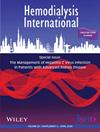The relationship between serum uric acid level and carotid intima-media thickness in hemodialysis patients
Abstract
Introduction
We aimed to evaluate the relationship between carotid intima-media thickness (CIMT), which is a known indicator of cardiovascular risk and atherosclerosis, and uric acid level, which may be an easy marker for cardiovascular diseases due to its antioxidant and pro-oxidant properties in hemodialysis patients.
Methods
In this cross-sectional study, we evaluated 77 hemodialysis patients. The mean CIMT of these patients was measured and recorded by Doppler ultrasonography. Patients were divided into two groups according to their serum uric acid levels. Correlation analysis and linear regression analysis were used to define the relationship between study parameters.
Findings
The mean CIMT levels in the normouricemic group and the hyperuricemic group were 0.95 ± 0.15 and 1.07 ± 0.15, respectively. There was a statistically significant difference between the two groups (p = 0.001). There was a statistically significant and moderate linear correlation between serum uric acid level and mean CIMT (r = 0.402; p = 0.002). Univariate and multivariate linear regression analyses were performed to identify variables that could independently affect the mean CIMT value. According to analysis, uric acid (p < 0.001), hypertension (p = 0.008), albumin (p = 0.029), and C-reactive protein (p = 0.042) were found independent risk factors for mean CIMT value.
Discussion
We found a significant relationship between serum uric acid level and CIMT, which indicates carotid atherosclerosis. Serum uric acid level is a low-cost laboratory parameter that can be measured in almost all laboratories, and it may be valuable in the hemodialysis patient group to identify patients at high risk of carotid atherosclerosis.

 求助内容:
求助内容: 应助结果提醒方式:
应助结果提醒方式:


